 |
| Category: Assorted |

|
|
|
|
|
|
Two Up or 'Swy', the Digger's
gambling game. |
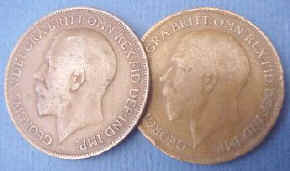 |
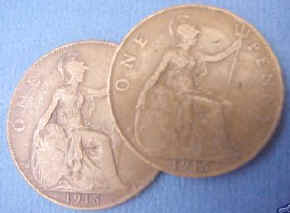 |
|
Two up pennies, 1915
British, as used in France |
| A
gambling game. Two coins are tossed in the air and bets placed on a
showing of two heads or two tails. The two coins are placed tails up on
a flat board called the kip or paddle.
The ring-keeper (the
person in charge of the two-up ring)
calls "come in spinner",
and the spinner tosses
the coins. First recorded 1854. (As in boxing the "ring" is
sometimes square.) |
|
Toss
the coins (using a 'paddle' or 'kip' ) and two heads you win, one of each toss again, or a pair of
tails you lose.
"Come in
Spinner" |
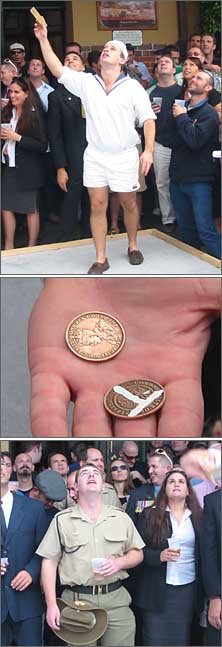 |
|
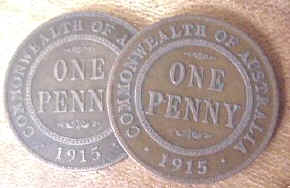
|
| Pennies for the game of 'two-up'.
Australian, 1915. As used in WW1 and WW2. |
 Punters wave five dollar notes above their heads as they yell for bets.
Punters wave five dollar notes above their heads as they yell for bets.
Once they are placed, a recruit from the raucous crowd flips the coins,
which must spin above the flipper's head and land within the special
demarcated two-up square (the "ring").
Shouts go up as the coins are flung
and there's much swearing and cheering as money changes hands.
And then it starts all over again.
As can be seen from the central photo
organised "schools" mark the coins for easy identification.
From an article on line by the Sydney Morning Herald,
2004. |
"Two-up" is a traditional game which is true-blue Australian, invented in old Australia, and allowed to played LEGALLY in public only on special days, such as ANZAC Day public holiday, since it's actually gambling...Of, course you can gamble and play it any time in an Australian casino.
A smooth area of 3 metres diameter is used with any number of players participating.
- Here's the terminology used in the game:
- KIP : Piece of wood on which the pennies (coins) are placed for spinning
(called "paddle" in some places)
- RINGER : Person in charge of the game
- SPINNER : Player spinning the coins
- COCKATOO : Keeps a lookout for the "Law" aka Police !
The RINGER will call for the "SPINNER" who will place a bet with the "BOXER". When this is set, side bets may be made, for either Heads or Tails. The "RINGER" will then call "Come in Spinner", the "SPINNER" will then walk into the centre of the RING and
toss the coins upwards.
If the coins land with 2 Heads facing UP, it is called "HEADS". 2 Tails is called "TAILED THEM", and when one of each is showing, then it is "ODDS". The coins must be tossed until a result is obtained.
The game is for the "SPINNER" to spin as many pairs of "HEADS" as possible.
When 2 Tails are showing, the "SPINNER" passes the "KIP" to another person. The modern game is now played with three coins thus giving a quicker result i.e. 2 HEADS or 2 TAILS. |
| The
Australian Army two-up set with display box, commemorating 100 years of
service to the nation
Since its formation in March 1901, the
Australian Army has fought in every major world conflict of the 20th
Century, most recently becoming involved in UN peacekeeping missions.
The Australian Army has not just defended Australia but played an
important role in protecting the rights of people in other countries. In
2001, we celebrated the Centenary of the Australian Army and the
traditions forged by our troops over the years.
Two-Up is one of Australia's oldest
military traditions. This beautifully displayed set features two special
commemorative brass-finished pennies, each struck with a leaping
Kangaroo on the reverse and the Australian Army centenary crest on the
obverse. The jarrah kip measures 190mm x 45mm x 10mm. The set comes in
as new condition in the display box of issue, along with an official
information card. |
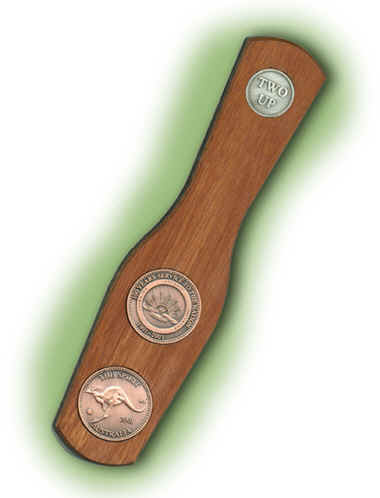 |
|
History of the two-up set |
|
From the AWM site |
|
In the following account, Mr M. G.
Heuston, who served with 2/12th Commando Squadron, during the Second World
War, describes the history of his two-up set.
While assessing the
profitability and “legality” (i.e., being able to be discreetly
obvious to potential players, but not really obvious to management within
the area) [of running a game of swy or two-up ,
as it was better known in the Middle East], I met a Middle East instructor
who was awaiting discharge on medical grounds. He had a very nice set of
pennies and a lot of experience in running. I was also told by him that
the bulk of the “very new Queen”, “young Queen”, the “veiled
Queen” and many of the “Baldies” pennies had been given to him by
his father who used them through the First World War. There were also a
number of British George V pennies and one set of the only Australian
penny of George V.
After negotiation, I
acquired at a price the game and the right to run it in my unit at
Bathurst.
From Bathurst I moved to
Canungra. There was virtually no free time to use the pennies at all here.
I staged in Brisbane and ran a few games before heading by train to
Townsville (Armstrong’s paddock). I ran quite a few lucrative games
there before being transferred to Morotai.
On this trip the convoy met
some hostility, which meant that we sought the safety of Biack Harbour,
where we hove to for some eight days. It was on the ship that the rule of
tossing pennies in a circle was changed to utilise a hatch cover. If the
pennies stayed on the hatch cover, they were in play.
From there we moved to
Morotai, and while waiting for action in Borneo I conducted an extremely
large (and lucrative) game at the back of our staging area. Many
nationalities were attracted by my game. I later arrived at Labuan just
off the west coast of Borneo, where, after all action had been completed,
I ran a few games.
From there, the unit
transferred to the Lintang Barracks on the outskirts of Kuching, where I
was able to conduct some more games in my spare time, when not looking
after the thousands of Japanese prisoners who were being held in case they
were needed for evidence in the war crimes trials.
Then we went back to Labuan
in Borneo, where we were on-shipped to New Britain and staged in a camp in
Rabaul, not near the harbour but over Tunnel Hill. Here I got myself a
position as sports manager and organiser to the unit, and as well as
running football, athletics and basketball, I had the position and the
time to conduct the swy game.
When I was eventually
shipped back to Australia I quickly put all my pennies away and did or
said nothing about them until this year [ 2002], when someone who knew me
asked me to give a talk about it at Rotary. With this encouragement, I
organised the set and prepared the pennies for forwarding to the
Australian War Memorial. |
|
The game of two-up |
|
from the AWM site |
| M. G. Heuston, who served with 2/12th
Commando Squadron during the Second World War, ran a two-up game during
this time. In the following account, he gives explains how the game was
played.
To stage a game required a quiet spot,
with a flat area big enough for an 18- or 20-foot radius circle clearly
etched in the dirt. This was done with twine, with two loops, one at each
end, using bayonets to mark the circle.
The boxer or
manager of the game sat with his coins, kips, string and money tray in the
place where he could view the whole ring clearly.
The ringie, who
was usually a friend who volunteered, ran the centre of the ring.
When the game was about to commence,
there would be a number of people around and outside the circle. The boxer
would call and ask for a spinner, who would have
the right to select whether he wanted to play two-up or swy
(also know as “sudden death”).
The kip would
then hold two or three pennies, depending on the game. (Some of the kips
were smooth, with no ridges in the wood. It was illegal for anyone to use
their fingers in the game I ran, so we had “lips” on the various kips
for right or left handed spinners who were not adept at using the smooth
kip. The plastic used on some of the kips I used was taken from crashed
planes on the side of the airstrip at Morotai.)
The spinner would then select the coins
that he wished to use (Queens, new or old, baldies,
George V, etc.).
The head side on each penny was polished
and the tail side was left dark, so that it was obvious to anyone around
the ring whether the coin fell as head or tail.
It was the ringie’s job to ensure that
the coins were tossed at least 10 feet into the air, and that they spun
well and were not “feathered” in any way. If the coins didn't’t
satisfy these specifications in his opinion, he would call “ foul
toss ” and catch one of the coins.
The ringie would place the coins tail up
on the kip. The call “come in spinner ” was made from
the box. The spinner then tossed the coins. All pennies (whether two or
three) had to fall within the circle. If one fell outside or on the
circle, it was declared void by the ringie. The spinner then had another
turn.
While this was happening, side bets were
allowed around the ring. There were two distinct types of betting:
- betting that the spinner would toss
heads or tails
- other tail betters would bet 3/1 that
heads would not be tossed twice.
In all cases, the bets were held in
front of the tail better, who covered them in every
instance before the boxer called “come in spinner”.
The spinner had the right to continue
spinning while ever he tossed heads. If he tossed three heads in a row,
the boxer would take his commission out of the centre (the guts)
and the spinner had the right to toss the kip (and
take the money) or continue spinning. The change of spinner went clockwise
around the ring.
If the spinner got to six heads in a
row, the boxer took another commission, and the game continued until the
spinner tossed tails or tossed the kip.
In some places, a multitude of
currencies was used. It was the boxer’s call which stated the exchange
rate for any or all currency. In addition, he could exchange currencies.
At the end of the game, if the tail
betters had had a good day, they would sling the
boxer, to compensate him for the use of his facilities.
As the game was held more often than
once a week, you found that some of your customers went broke. The boxer
usually lent them enough for cigarettes and a beer until next pay.
A game would run for up to three or four
hours.
Glossary of terms
- Boxer:
- the game owner.
- Ringie:
- the supervisor in the ring.
- Kip:
- the flat board used to throw the
coins.
- Spinner:
- the player who throws or tosses the
pennies.
- Queens,
Baldies, George V or VI:
- coins available for the spinner to
choose. (The Queen is Queen Victoria; the Baldie is Edward VII.)
- Toss the
kip:
- to pull out of the game and take the
stake.
- Tail-betters:
- the name for those who bet only on
tails. In most cases, they chose not to spin the coins.
- Sling:
- a tip given to the boxer
|
|